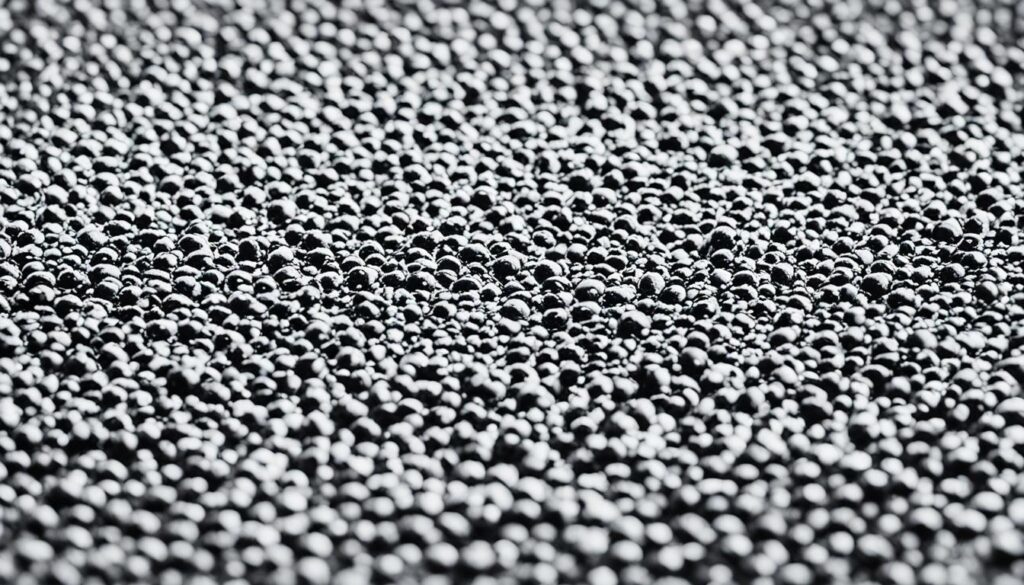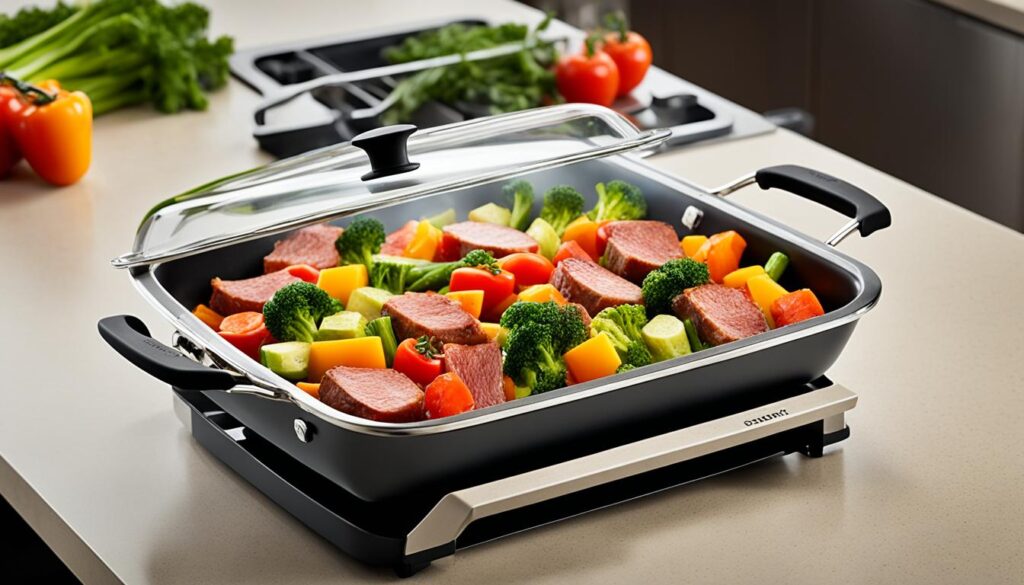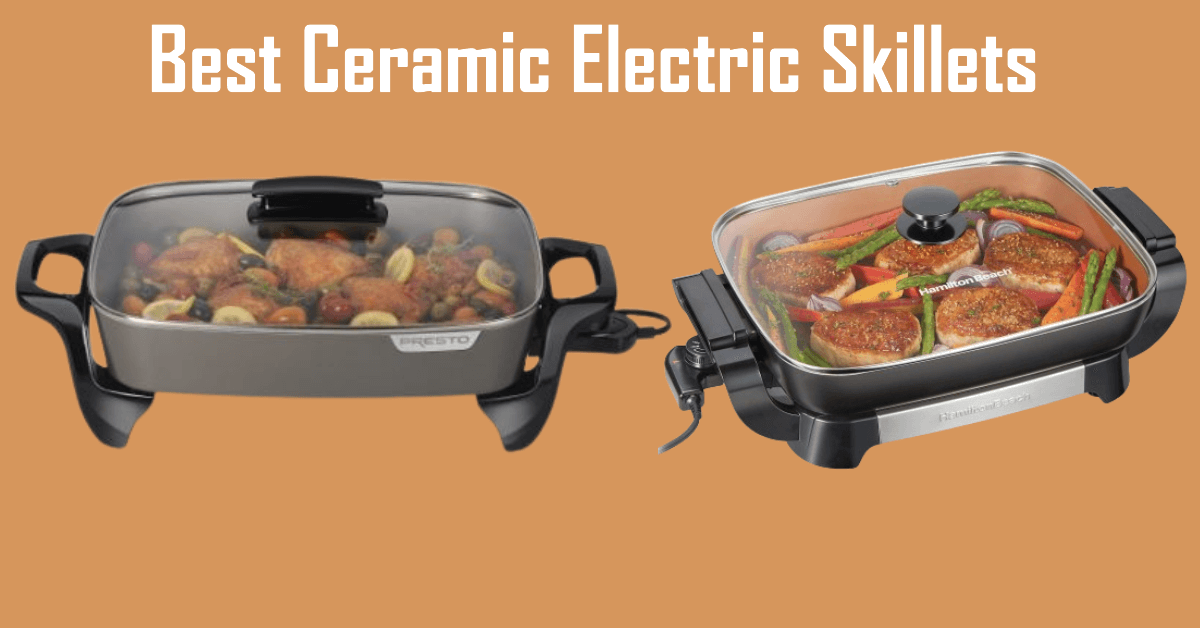Are you worried about the safety of ceramic electric skillets? Many now look for cookware that’s not full of harmful chemicals. The best ceramic electric skillets are seen as a safe choice. They offer natural, potentially safer ways to cook.
When I looked into ceramic electric skillet safety, I found out something interesting. These skillets have a coating made from sand and silica. It’s put on through a sol-gel process. This makes them PFAS-free and non-toxic, avoiding harmful materials like PFOA, lead, and cadmium. These substances can be bad for both our health and the world around us.
Past worry involved traditional PTFE (Teflon) coatings. There was fear they might release gases when heated a lot. The coating that used to have PFOA raises more health and environment questions.
Key Takeaways
- Ceramic electric skillets use a natural, sand-based nonstick coating.
- They are safe because they don’t have PFAS, PFOA, lead, or cadmium.
- While Teflon is mostly safe, concerns exist over gas release at high heat and past PFOA use.
- They are a top pick for healthier, eco-friendly nonstick cooking.
- Knowing the details about ceramic skillets helps you choose cookware more wisely.
Understanding Nonstick Cookware Materials
Nonstick cookware comes with two main coatings: PTFE (Teflon) and ceramic nonstick coatings. These materials have clear differences.
Traditional Nonstick Coatings: PTFE and PFOA
Traditional nonstick pans have used PTFE or Teflon for years. Though easy to clean, the original Teflon had PFOA, which is harmful. Yet, experts are not sure if PTFE itself can be harmful when it’s very hot.
Ceramic Nonstick Coatings: A Safer Alternative?
Ceramic nonstick coatings are a modern rival to PTFE. They’re applied using silica, from sand, known for being safer. Ceramic surfaces are also better for the planet and health since they don’t have PFAS, PFOA, lead, or cadmium.

Many are turning to PFAS-free cookware like ceramic. But, these coatings might not last as long as PTFE ones. They also might not be as strong,
| Brand | Model | Weight | Release Date |
|---|---|---|---|
| Oster | CKSTSKFM05 16-Inch Electric Skillet | 4.24 lbs | March 2008 |
| Oster | CKSTSKFM16W-TECO Titanium-Infused Duraceramic Electric Skillet | 7.75 lbs | July 2018 |
| Elite Platinum | EG-6203 Non-stick Deep Dish Heavy Duty Electric Skillet | 9.88 lbs | March 2017 |
| Hamilton Beach | 38528R Deep Dish Durathon Ceramic Skillet | 7.6 lbs | August 2017 |
The table shows top brands making extra large electric skillets with ceramic coatings. This reflects the rise in ceramic cookware’s popularity.
Advantages of Ceramic Electric Skillets
Ceramic electric skillets are great for healthy and eco-friendly cooking. They are free from harmful substances like PFAS, PFOA, lead, and cadmium. This makes them a safe and eco-conscious choice.
Free from PFAS, PFOA, Lead, and Cadmium
Ceramic skillets are different from traditional nonstick cookware. They are made using natural materials like sand and silica. This means they are safe and don’t have harmful chemicals.
Easy Food Release and Cleanup
Ceramic skillets’ nonstick surface makes cooking and cleaning up a breeze. Food doesn’t stick easily. This means you need less oil and cleaning is simpler. Plus, many are okay to put in the dishwasher.

| Model | Weight | Wattage | Temperature Range | Nonstick Coating |
|---|---|---|---|---|
| Presto 06857 | 8.55 lbs | 1500 Watts | 200° to 400° F | Ceramic |
| Hamilton Beach 38529K | 8 lbs | 1500 Watts | 200° to 400° F | Durathon Ceramic (PFOA and PTFE-free, 4X more durable than Teflon) |
| AEWHALE Electric Skillet | 8 lbs | 1400 Watts | 250℉ to 460℉ | Ceramic |
These ceramic skillets are light, strong, and offer many cooking options. The Hamilton Beach has a special Durathon Ceramic coating. It’s both durable and free from harmful chemicals, a top non-toxic cookware choice.
Versatility of Ceramic Electric Skillets
Are you a cook looking for one tool to do it all? Then, check out ceramic electric skillets. They can fry, sauté, bake, grill, and even steam food. This makes them perfect for many cooking tasks.
5-in-1 Design for Multiple Cooking Methods
Ceramic electric skillets stand out with their 5-in-1 design. They can do everything from making pancakes for breakfast to searing steaks for dinner. Their big cooking space fits dishes like omelets, risottos, and even full meals.

Precise Temperature Control
These skillets shine with their precise temperature control. You can set the heat from low to high, customizing it for each meal. Some even heat up quickly and evenly, thanks to their special design.
Let’s take the Elite Gourmet Electric Skillet for example. It has a dial to set temperatures from 200-400°F. With 1200 watts of power, and it’s also safety certified. This skillet gives you unmatched control and safety.
| Feature | Specification |
|---|---|
| Temperature Range | 200-400°F |
| Wattage | 1200 watts |
| Safety Certification | ETL certified |
| Pan Size | 8″ x 8″ |
| Serving Capacity | 3-4 people |
Durable and Long-Lasting Construction

Ceramic electric skillets stand out because of their durable and long-lasting build. They have reinforced ceramic coatings for scratch resistance and long-lasting durability. This is unlike regular nonstick skillets that get worn out over time.
Reinforced Ceramic Coatings for Scratch Resistance
Top brands like BELLA and Hamilton Beach have created ceramic coatings that are up to 10 times stronger than usual nonstick. For example, the BELLA Copper Nonstick Skillet has been tested and shown to be eight times tougher than typical nonstick.
These reinforced ceramic coatings can handle the use of metal utensils and don’t chip off. This makes sure they stay nonstick for a long time. The Hamilton Beach Durathon Skillet is one such example with a super durable Durathon ceramic nonstick that’s easy to clean.
| Brand | Model | Durability Claim |
|---|---|---|
| BELLA | Copper Nonstick Skillet | 8x tougher than standard nonstick coatings |
| Hamilton Beach | Durathon Skillet | Surpasses traditional coatings in durability |
| CRUX | Deep Ceramic Skillet | 50% more cooking capacity than traditional pans |
Healthy and Eco-Friendly Cooking
For those who cherish living healthy and respecting the planet, choosing the right cookware is essential. Ceramic electric skillets stand out as a top choice. They offer safety and are gentle to the environment. They work amazingly well.
No Harmful Chemicals or Off-Gassing
Ceramic electric skillets boast a non-toxic quality. This means no dangerous fumes when they heat up. Traditional nonstick pans can release harmful chemicals when hot. But ceramic skillets use safe, all-natural materials. They contain no PFAS, PFOA, lead, or cadmium, keeping your cooking safe.

Environmentally Conscious Materials
Ceramic electric skillets are not only good for you but also good for the planet. Their natural source, often sand, makes them eco-friendly. This meets the growing need for eco-friendly products. Consumers are keen on buying items that help the environment.
When you pick a ceramic electric skillet, you get a two-fold benefit. On one hand, there’s the ease of cooking with nonstick. On the other, you promote a healthy and environmentally-friendly lifestyle. These skillets lead in merging high function with the safety of the planet.
| Cookware Type | Materials | Eco-Friendly | Non-Toxic |
|---|---|---|---|
| Traditional Nonstick | PTFE (Teflon), PFOA | ❌ | ❌ |
| Ceramic Electric Skillet | Sand, Silica | ✅ | ✅ |
| Cast Iron | Iron | ✅ | ✅ |
| Stainless Steel | Steel, Chromium | ✅ | ✅ |
Choosing the Right Ceramic Electric Skillet
Choosing a ceramic electric skillet for my kitchen means looking at two main things: how much it can hold and if it’s easy to use. I make sure it’s big enough to cook the amount of food we need. It should also feel right for our family size.
Capacity and Size Considerations
If you cook for a family or like to make lots of food, go big. Look for a 6-quart or 12-inch skillet. These are great for making big meals like paella. If it’s just you or a couple, a smaller skillet will do for regular meals.

I think about what I usually cook to choose the right size skillet. Are there big family dinners often? Or is it mainly for simple, small meals? The answers help me pick the perfect size for my cooking life.
User-Friendly Features
How easy it is to use the skillet matters too. I like skillets with handles that don’t get hot and are easy to hold. Glass lids let me see my food as it cooks without losing heat or moisture.
Also, look for skillets with pans that come out. This makes it easy to serve and clean up. Some skillets can even be used by both right- and left-handed people.
| Skillet | Capacity | Key Features | Best for |
|---|---|---|---|
| Cuisinart Electric Skillet | 6 quarts | Nonstick surface, glass lid, adjustable temperature control | Family cooking, entertaining |
| Black and Decker 12×15-inch Electric Skillet | 12×15 inches | Affordable, nonstick surface, adjustable temperature control | Best value pick |
| All-Clad Electric Nonstick Skillet | 7 quarts | Premium quality, durable nonstick surface, even heat distribution | Upgraded option for serious home cooks |
| Zojirushi Gourmet d’Expert Electric Skillet | 4.5 quarts | Compact size, precise temperature control, titanium-reinforced nonstick coating | Small servings, singles or couples |
| Presto 16-inch Electric Skillet | 16 inches | Large capacity, nonstick surface, tempered glass lid | Feeding larger groups, big families |
Care and Maintenance Tips
It’s vital to keep your ceramic electric skillet in good shape. This ensures it lasts long and works well. By taking care of it and sticking to the guidelines, you’ll cook easily and clean up without hassle for years.
Proper Usage Guidelines
To keep the nonstick ceramic coating safe, avoid too much heat. Don’t heat the skillet when it’s empty either. High heat and no food can harm it. It’s better to use non-metal utensils. This helps prevent scratches and keeps the nonstick surface working well for longer.
Recommended Cleaning Methods
Cleaning is key to keep your ceramic electric skillet looking good and working well. Many models can go in the dishwasher, which is easy. But for the best care, wash it by hand. Use mild soap and a soft sponge or cloth. Stay away from rough scrubbers. They can ruin the ceramic surface over time.

These are several more tips for cleaning and keeping your ceramic electric skillet in good condition:
- Always clean the skillet right after you use it. This stops food from sticking and staining.
- Check the skillet regularly for any brown spots and take care of them quickly.
- Let the skillet cool down completely before washing. This prevents damage from sudden temperature changes.
- For tough stains, soak the skillet in warm, soapy water for at least half an hour. Or use a mix of water and white vinegar overnight.
- If it’s discolored, put some 3% hydrogen peroxide in and let it sit for 30 minutes. Then scrub it gently.
Comparing Ceramic and Traditional Nonstick Skillets
Ceramic and traditional nonstick skillets are both great for the kitchen. They’re easy to cook with. But, they differ in how well they stay nonstick and last. Ceramic skillets are a more natural choice, while traditional skillets are tough against scratches.
Performance and Durability
Ceramic skillets are eco-friendly, using a coating made from sand. This makes them a better choice for the environment. Yet, they might not last as long or stay as nonstick as traditional skillets.
Traditional skillets with PTFE (like Teflon) are known for their strong, lasting nonstick abilities. The T-fal fry pan is a top pick because its coating keeps up over time.

Cost and Value for Money
Ceramic skillets often cost more at first. They’re seen as a top-notch, green option. But many like the safety and eco-friendliness of ceramics.
Which to pick depends on your budget and needs. Ceramic skillets might cost more, but their natural material is attractive. Traditional skillets are less expensive, yet may wear out sooner.
| Feature | Ceramic Skillets | Traditional Nonstick Skillets |
|---|---|---|
| Nonstick Coating | Silica-based, naturally derived | PTFE (Teflon) |
| Durability | Reinforced coatings improve scratch resistance, but generally less durable than PTFE | Long-lasting, durable PTFE coatings |
| Price Range | Higher initial cost, often marketed as a premium option | More affordable, lower price point |
| Environmental Impact | Eco-friendly, PFAS-free coatings | Traditional PTFE coatings may raise environmental concerns |
Top Recommended Ceramic Electric Skillets
Choosing a great ceramic electric skillet is not easy, but I’ve found the best ones. As someone who loves cooking at home, I’ve tested many different models. The best ones are great because they perform well, last a long time, and are easy to use.
Hamilton Beach Electric Skillet with PFAS-Free Durathon Ceramic Coating and Removable 12×15″ Pan
The Hamilton Beach Electric Skillet is both tough and flexible. It has a special Durathon ceramic nonstick coating that doesn’t crack or peel. The large 12×15″ pan can be taken off for easy serving and cleaning. Plus, you can cook at temperatures from 200°F to 400°F, giving you many cooking choices.
GreenLife Healthy Ceramic Electric Skillet with Glass Lid
The GreenLife Healthy Ceramic Electric Skillet is great for the planet and your health. It uses a ceramic coating that’s free from harmful chemicals. This means it’s safe for you and the environment. It can do five different types of cooking, comes with a clear lid for watching your food, and lets you control the heat precisely.
Presto 16-Inch Ceramic Electric Skillet
Need something big for family meals or parties? The Presto 16-Inch Ceramic Electric Skillet is perfect. It’s 16 inches wide and has a deep cooking area. Food won’t stick because of its ceramic surface, and cleanup is simple. You can also cook more efficiently with its even heat and a lid to keep things under control.
CRUX Ceramic Electric Skillet with Glass Lid
The CRUX Ceramic Electric Skillet is unique because it’s deep and has a strong copper ceramic coating. It offers 50% more space for cooking than usual. The copper ceramic is super tough and you can even use metal utensils with it. It heats up to 400 degrees and has a powerful 1200-watt system. This means it’s perfect for different cooking styles.
GreenPan Elite Essential Smart Ceramic Electric 6QT Skillet Pot
The GreenPan Elite Essential Smart Ceramic Electric 6QT Skillet Pot is a top choice for those who want the latest features and care about the environment. It’s very durable and heats evenly. An embedded heater spreads heat fast, and you can adjust the temperature precisely. The glass lid helps keep flavors and moisture in while cooking, and it’s easy to clean.
